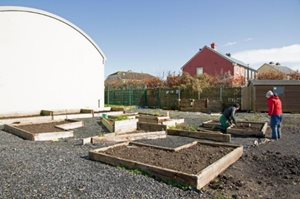Quay Community Garden

The Quay Community Garden was the initial project devised by the Quay Community Project. Back in 2009, it was identified that there was a lack of community activity in the Quay area of Westport, and the lack of facilities to bring people together within the community. The Community Garden was one of a number of ideas conceived of by the Project. The Project was a collaboration between local residents, Westport Family and Community Resource Centre, and Westport Town Council. Like many projects initiated since then in the community, the Garden was and is operated around the principles of community development, where local people are empowered to take ownership of their project, and the participants in the garden are critical to decision making around the direction of the garden.
A small site was identified at the back of Ocean View, and a team of local residents and Family Resource Centre staff began the back-breaking work of turning the ground into a patch where vegetables could be grown. Those early days were marked by late evenings gathering stones, and breaking in the soil, but later that summer their efforts were rewarded with the first year of produce from the Garden. Lazy beds were constructed under the guidance of Eddie Domican, who worked with local residents on the planning of the garden.
The garden has a wide variety of features including a polytunnel, raised beds using recycled scaffold boards, a wormery, a compost heap, leaf/comfrey bins for potting compost for next year, an area for preparing these leaves for next year, a meadow of wild flowers with paths made from recycled materials, compost pits for green and brown waste materials, several comfrey beds, and a spiral herb garden. The Edible Landscape Project is next to the garden, which provides an additional focus to community members.
In 2014, a landscape plan and a crop rotation plan were developed to begin the new vegetable and fruit garden. Mayo County Council provided soil, gravel and a garden shed for the tools. Horse manure, the humus-compost base needed for the beds, was supplied by Drummindoo Stud, Westport and Westport Woods Hotel. A contribution from The Local Agenda 21 Environmental Partnership Fund paid for some seeds, onion sets and seed potatoes. In the past couple of years Compost pits and a Willow Arch has been built. A major development in 2017, was securing funding from Local Agenda 21 for the provision of a Polytunnel. The Polytunnel produced its first crop in 2018 and is a major addition to the Community Garden, especially in COVID times.
The Quay community garden has collaborated with other organisations/groups to date. Foroige members, Transition year students, horticulture students, TUS workers and members of the Men’s shed are among some of those who have come to help in the garden.
The Quay Youth Project allows young people to take part in the gardening under the auspices of the Family Resource Centre. They have access to the tunnel and garden, and it can be used at any time.
When the garden first acquired the polytunnel, a series of workshops took place to raise money. This year, in collaboration with Edible Landscape, Saturday Sessions were held with short talks on topics such as the circular economy, making your own potting compost, growing in fish boxes, etc. In more recent times, workshops took a different format whereby, a short video and a chart with instructions were produced for people to follow along with.
Other members of the community are always welcome, no experience necessary. Gardening is a great way for people to integrate into their local community.
Contact details: quaycommunitygarden@gmail.com or visit at F28 H1K6.
For further information visit the Quay Community Garden Facebook Page.
Biodiversity plaque
Children, mainly from Westport Quay, used the Gardening for Biodiversity handbook as a guide to developing a plaque representing the five golden plants. The idea arose during lockdown in early 2021 to do something useful for the environment and this is their result. The five plants dandelion, willow, clover, bramble and ivy are commonly grown in Ireland, sometimes identified as weeds, but they are a very important source of pollen for the bees from February to October. There are about eight plaques around the town - this means that some of these plants are growing nearby. This is a great way to raise awareness of the importance of these plants.
